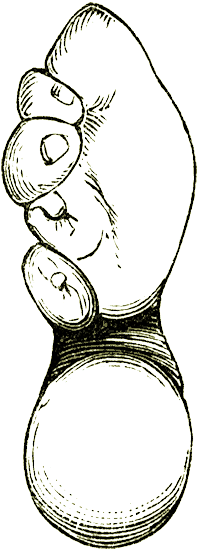Foot Binding in China

The Chinese tradition of binding girls' feet lasted for a thousand years. It was a uniquely Chinese tradition. The foot binding was seen as a mark of a family's affluence because women with bound feet could not undertake any physical labor such as working in the fields. The crippling of the feet forced women to walk in short steps and this was considered sexually attractive. The feet became the indispensable object of sexual foreplay. They were called ‘lotus feet’. A daughter with bound feet was more likely to marry ‘well’ and this was another incentive for the cruel practice to be continued. Daughters were willing to undergo it as it was a passport to avoid endless toil out in the fields.
Many western missionaries in the 19th and 20th centuries sought to bring the custom to an end. In 1895, Alicia Little, wife of an English trader, established the ‘Natural Foot Society’ (Tian zhu hui) in Shanghai. Perhaps the most famous example was documented by the English missionary Gladys Aylward ➚ in the book ‘The Inn of the Eight Happinesses’ which became a Hollywood epic film in 1959 as the ‘Inn of the Sixth Happiness’ ➚. In these days of strong anti-foreigner feeling these well-meant initiatives may actually have delayed its abandonment as foot-binding was perceived as part of distinctive Chinese culture under threat from foreign powers.
Bone breaking
The process of foot-binding started at a very young age (between the ages of 2 and 6) , when the bones are still supple. It was too late to start the process after the age of ten. The main bones were deliberately broken. The four smaller toes of each foot are gradually bent downwards and inwards. To achieve this, the feet are bound with wet cloths that shrink on drying compressing the foot. The binding cloths, often soaked with medicinal herbs, were kept on day and night during the whole time that the feet continued to grow. After gradual bending over a few years the big toe curved downwards and the four other toes are wrapped underneath forming a very high instep. It was considered that the shorter the length of foot the more attractive it was. Three Chinese inches was considered the ideal with the description 三寸金莲 San Cun Jin Lian ‘Three-inch golden lotus’ although four or five inches was the most that could normally be achieved. Even as late as the 1950s it was said female beauty was 30% pretty face but 70% lily feet. Women walked slowly and painfully on the bent-over toes. It put them in danger in case of fires - they could not run away quickly. Some considered the inability to walk or easily run away a means by which men controlled their women, but the practice was carried out in the home by mothers on their own daughters.

History of foot-binding
According to one story the custom began around 580CE in emulation of an emperor 's favorite concubine. Another story is from the Song dynasty (around 965CE) of Emperor Liyu's infatuation with a dancer and another that it began with Xiao Baojuan ➚ (483-501). It grew very slowly as a badge of wealth and ambition, at first only within the leading families at the Imperial court. By 1000CE it had become widespread and for centuries thereafter about half of all girls had their feet bound. It became a badge of wealth and gentility as a successful marriage could turn around a family's fortunes. Only minority peoples and very poor families who needed girls to carry out physical labor did not do it. The tradition became so entrenched that when Qing Emperor Kangxi banned the practice in 1664 he had to admit defeat and revoke the ban four years later; this may have been brought in because Manchu women did not have their feet bound. One of the reforms brought in by the Taiping rebels was the prohibition of foot-binding.
By 1902 intellectuals no longer inflicted it on their daughters and it became subject to an ineffective ban under the Republican government. Some women then put themselves through the painful process of straightening the feet so they could walk normally again. In the 19th and 20th centuries foot-binding became the cause of much denigration of Chinese culture. In 1851 a ‘Chinese Lady’ with 2½ inch feet was exhibited in London in what was more or less a freak show. Kang Youwei ➚ observed ‘Now China is narrow and crowded, has opium addicts and streets lined with beggars. Foreigners laugh at us for these things, and criticize us for being barbarians. There is nothing which makes us objects of ridicule so much as foot-binding.’ However, particularly in rural areas the practice lingered on into the mid 20th century, it was the Communist government that eventually eradicated it. The last known woman Han Qiaoni ➚ to have bound feet died as late as 2013 although it is possible that one or two remote rural villages in far flung provinces still cling to the custom.